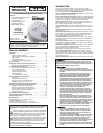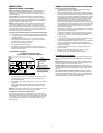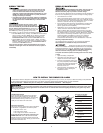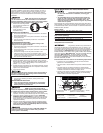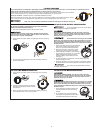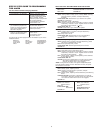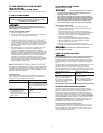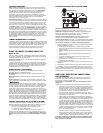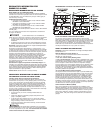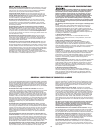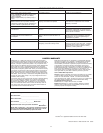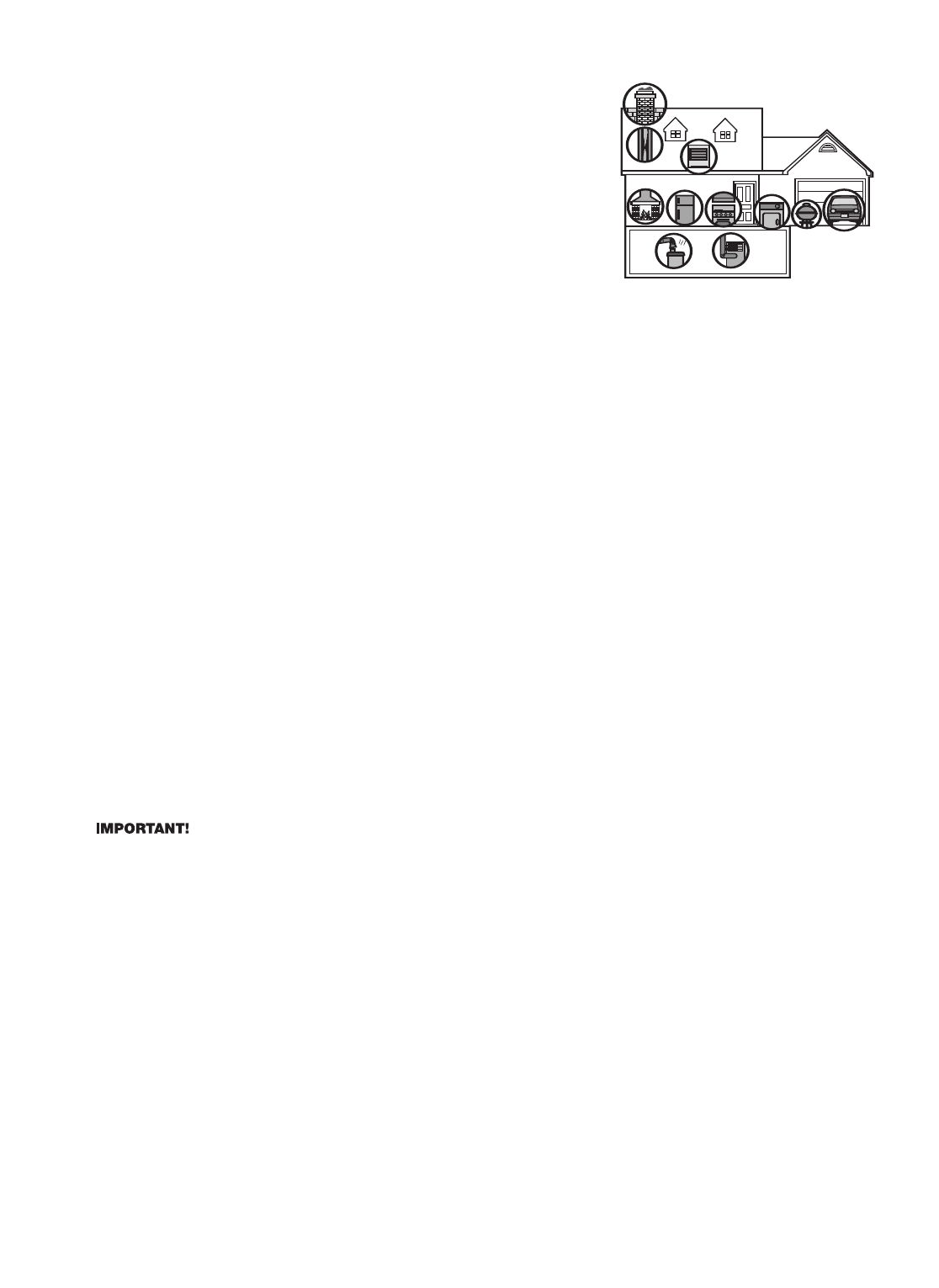
8
P
OTENTIAL SOURCES OF CO IN THE HOME
Fuel-burning appliances like: portable heater, gas or wood burning
f
ireplace, gas kitchen range or cooktop, gas clothes dryer.
Damaged or insufficient venting: corroded or disconnected water
h
eater vent pipe, leaking chimney pipe or flue, or cracked heat
e
xchanger, blocked or clogged chimney opening.
Improper use of appliance/device: operating a barbecue grill or
v
ehicle in an enclosed area (like a garage or screened porch).
Transient CO Problems: “transient” or on-again-off-again CO problems
c
an be caused by outdoor conditions and other special circumstances.
The following conditions can result in transient CO situations:
1. Excessive spillage or reverse venting of fuel appliances caused by
outdoor conditions such as:
•
Wind direction and/or velocity, including high, gusty winds.
Heavy air in the vent pipes (cold/humid air with extended periods
between cycles).
• Negative pressure differential resulting from the use of exhaust
f
ans.
• Several appliances running at the same time competing for
l
imited fresh air.
•
Vent pipe connections vibrating loose from clothes dryers,
furnaces, or water heaters.
• Obstructions in or unconventional vent pipe designs which can
amplify the above situations.
2. Extended operation of unvented fuel burning devices (range, oven,
fireplace).
3. Temperature inversions, which can trap exhaust close to the ground.
4. Car idling in an open or closed attached garage, or near a home.
These conditions are dangerous because they can trap exhaust in your
home. Since these conditions can come and go, they are also hard to
recreate during a CO investigation.
WHAT YOU NEED TO KNOW ABOUT CO
WHAT IS CO?
CO is an invisible, odorless, tasteless gas produced when fossil fuels
do not burn completely, or are exposed to heat (usually fire). Electrical
appliances typically do not produce CO.
These fuels include: Wood, coal, charcoal, oil, natural gas, gasoline,
kerosene, and propane.
Common appliances are often sources of CO. If they are not properly
maintained, are improperly ventilated, or malfunction, CO levels can rise
quickly. CO is a real danger now that homes are more energy efficient.
“Air-tight” homes with added insulation, sealed windows, and other
weatherproofing can “trap” CO inside.
SYMPTOMS OF CO POISONING
These symptoms are related to CO POISONING and should be
discussed with ALL household members.
Mild Exposure: Slight headache, nausea, vomiting, fatigue (“flu-like”
symptoms).
Medium Exposure: Throbbing headache, drowsiness, confusion, fast
heart rate.
Extreme Exposure: Convulsions, unconsciousness, heart and lung
failure. Exposure to Carbon Monoxide can cause brain damage, death.
This CO Alarm measures exposure to CO over time. It alarms if CO
levels are extremely high in a short period of time, or if CO levels reach
a certain minimum over a long period of time. The CO Alarm generally
sounds an alarm before the onset of symptoms in average, healthy
adults. Why is this important? Because you need to be warned of a
potential CO problem while you can still react in time. In many reported
cases of CO exposure, victims may be aware that they are not feeling
well, but become disoriented and can no longer react well enough to
exit the building or get help. Also, young children and pets may be the
first affected. The average healthy adult might not feel any symptoms
when the CO Alarm sounds. However, people with cardiac or respiratory
pr
oblems, infants, unbor
n babies, pr
egnant mothers, or elderly people
can be more quickly and severely affected by CO. If you experience
even mild symptoms of CO poisoning, consult your doctor immediately!
FINDING THE SOURCE OF CO AFTER AN ALARM
Carbon monoxide is an odorless, invisible gas, which often makes it
dif
ficult to locate the sour
ce of CO after an alarm. These ar
e a few of
the factors that can make it difficult to locate sources of CO:
• House well ventilated before the investigator arrives.
• Problem caused by “backdrafting.”
• Transient CO problem caused by special circumstances.
Because CO may dissipate by the time an investigator arrives, it may
be dif
ficult to locate the source of CO.
BRK Brands, Inc. shall not be
obligated to pay for any carbon monoxide investigation or service
call.
L
ATCHING FEATURES
Alarm Latch is activated after an Alarm is exposed to alarm levels of
s
moke or carbon monoxide. This feature will only work with AC power.
A
fter smoke or CO levels drop below alarm levels, the
“
Smoke/Power”
or “CO” Red LED will begin to flash once every few seconds. It will
c
ontinue to flash or “latch” until you clear it by testing the alarm.
T
his feature helps emergency responders, investigators, or service
t
echnicians identify which unit(s) in your home were exposed to alarm
levels of smoke or carbon monoxide. This can help investigators
p
inpoint the source of smoke or CO.
Interconnected Alarms. Latching Alarm Indicator shows which Alarm(s)
i
n the series were exposed to alarm levels of smoke or carbon monoxide.
T
he Latching Alarm Indicator stays ON until you clear it, so it can alert
you to an alarm that occurred while you were away from home, even
t
hough smoke or CO present in the air has dropped below alarm levels.
L
ow Battery Latch
i
s activated when the Alarm is in the "low battery
c
ondition". When this occurs, the
S
moke/Power
L
ED flashes Green On
for 2 seconds/Off for 2 seconds. This feature is designed to help you
i
dentify which Alarm needs to have the battery replaced. Although, the
A
larm will sound the low battery chirp approximately once every minute,
sometimes during the initial stages of "low battery", the Alarm will chirp
i
n greater intervals than one minute, sometimes up to several hours,
until the battery reaches a steady low battery level. This innovative
feature eliminates the frustration of waiting for and/or identifying which
u
nit is chirping.
“SMART INTERCONNECT” FEATURE
This Alarm includes "Smart Interconnect" which enables the Alarm to be
i
nterconnected with other First Alert
®
a
nd BRK Smoke, Heat, and "Smart
I
nterconnect" CO Alarms. When smoke is detected, all Alarms will sound
the smoke hor
n pattern. When CO is detected, "Smart Interconnect"
A
larms will sound the CO horn pattern. Alarms that do not have the
"
Smart Interconnect" feature will remain silent during a CO alarm.
HOW CAN I PROTECT MY FAMILY FROM
CO POISONING?
A CO Alarm is an excellent means of protection. It monitors the air
and sounds a loud alarm before Carbon Monoxide levels become
threatening for average, healthy adults.
A CO Alarm is not a substitute for proper maintenance of home
appliances.
To help prevent CO problems and reduce the risk of CO poisoning:
• Clean chimneys and flues yearly. Keep them free of debris, leaves,
and nests for proper air flow. Also, have a professional check for
rust and corrosion, cracks, or separations. These conditions can
prevent proper air movement and cause backdrafting. Never “cap”
or cover a chimney in any way that would block air flow
.
•
T
est and maintain all fuel-bur
ning equipment annually
. Many
local gas or oil companies and HVAC companies offer appliance
inspections for a nominal fee.
• Make regular visual inspections of all fuel-burning appliances.
Check appliances for excessive rust and scaling. Also check the
flame on the bur
ner and pilot lights. The flame should be blue.
A yellow flame means fuel is not being burned completely and
CO
may be pr
esent. Keep the blower door on the fur
nace closed.
Use vents or fans when they are available on all fuel-burning
appliances. Make sure appliances are vented to the outside. Do
not grill or barbecue indoors, or in garages or on scr
een por
ches.
•
Check for exhaust backflow fr
om CO sources. Check the draft
hood on an operating fur
nace for a backdraft. Look for cracks
on furnace heat exchangers.
• Check the house or garage on the other side of shared wall.
•
Keep windows and doors open slightly
. If you suspect that CO
is escaping into your home, open a window or a door. Opening
windows and doors can significantly decr
ease CO levels.
In addition, familiarize yourself with all enclosed materials. Read
this manual in its entirety, and make sure you understand what to
do if your CO Alar
m sounds.



